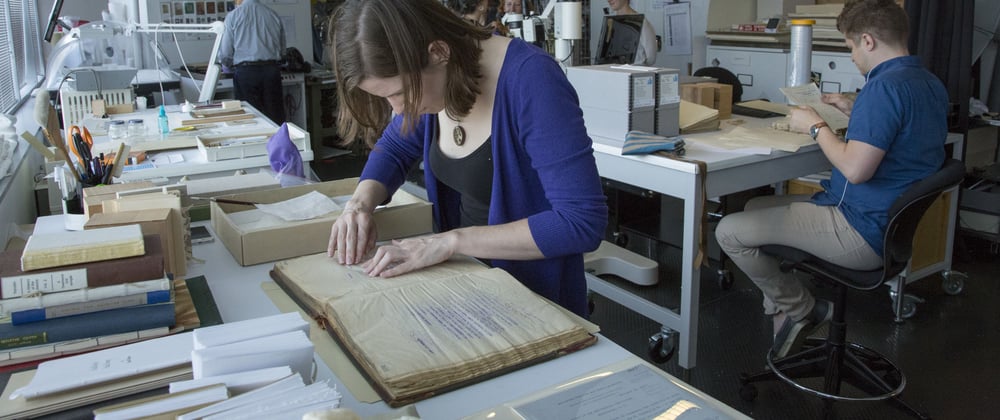Preservation is defined as the field of protecting materials from chemical or physical damage as well as the acts associated with doing so. Conservation is similar to preservation, except conservation efforts focus on repairing and restoring that which has already been damaged to ensure the survival of the original material. These activities are both done in order to ensure the long-term preservation of knowledge and of cultural artifacts.
In library and information centers preservation is done mostly through proper handling, environmental control and disaster preparedness. Proper handling is simply making sure that the items are handled with respect and stored in ways that will not cause damage to them over time.
Environmental control entails keeping the items in an environment that will slow down their chemical deterioration. The main environmental factors that need to be controlled to ensure this are temperature, humidity, and both visible and UV light. Optimal environmental conditions are not the same for different materials, so either a balance must be struck or different materials should be kept separately under different environmental conditions. In general, lower temperatures and dark environments slow down chemical decomposition and are also a deterrent for mold and insects. However, since these conditions are not optimal conditions for humans to enjoy viewing these materials it is again necessary to compromise. It is also notable that quickly changing the environmental temperature is not advisable. Most information resources themselves are made up of different materials that contract and expand at different rates, so rapid temperature change can cause undue stress on these resources.
For both mold and insect problems it is important to regulate temperature and humidity. For mold specifically it is important to have a good ventilation system and to regularly clean and vacuum. For insect prevention it is a good idea to not allow food and drink, and to call for professional help for significant infestations.
Disaster preparedness is basically having a plan in place for any possible disaster. This ranges from floods, storms, tsunamis, tornadoes to malfunctioning pipes, fires and terrorist attacks. To prepare for these disasters it is first important to take note of any problems that might arise from the structure of the library, including noting where the fire extinguishers and shut-offs are for the water, electricity and gas systems. Next is meeting with local fire and safety officers and devising procedures for each disaster. After which it is important to establish a priority list for which library staff need to be contacted in what order and a priority list of what materials should attempt to be salvaged. In the event that a disaster occurs during work hours it is also possible to assign staff to attempt to rescue certain valuable or irreplaceable collection items. Next is creating a communication plan for notifying the public online or offline. Lastly is cultivating a stock of recovery supplies and a list of contacts that can provide resources to aid in recovery.
With the rise of new forms of media, digital preservation is a new field of preservation that involves making sure that digital forms of media can continue to be both stored and accessed. It is a field that is concerned with both natively digital resources and resources that were digitized. The main concerns of digital preservation are making sure that digital media storage keeps up with rapidly changing technologies and that as little data as possible is lost when switching to new technologies. This process involves both the format that the data is stored in and the software and hardware needed to access that type of data format. One issue that digital preservation faces is the fact that many companies that hold the rights to digital information resources have no incentive to continue spending money preserving these when they no longer generate profit. This is an ongoing issue that has no clear solution yet.
Conservation involves repairing and stabilizing materials, usually those that are still in circulation or those that are culturally valuable. The goal of conservation is to increase and items permanence and shelf-life. For print materials, major conservation concerns include the pH levels of the material, the condition of the paper and binding and the shelving conditions. Binding can degrade over time, and paper can acidify and embrittle. It is important that conservation efforts are done by trained staff who use the proper materials, as improper conservation efforts always do more damage to the material. In general, conservation is costly and in some cases it may be better to seek replacement copies and dispose of or store damaged items.
Like all libraries around the world, Philippine libraries engage in preservation and conservation efforts. For the Philippines, libraries must center their preservation efforts and temperature and humidity control. The hot and humid climate is sub-optimal for most information resources, and is also a breeding ground for mold and insects. As for natural disasters, the most common ones are severe storms and floods, meaning that all libraries should be equipped with items that will help salvage resources from water damage, such as butcher's paper and plastic sheeting. Conservation efforts in Philippine libraries focus on Filipino cultural heritage items, and are usually undertaken by the National Library of the Philippines.







Top comments (0)